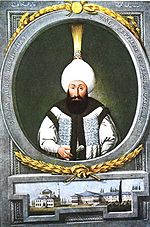- Abdul Hamid I
-
 Abdul Hamid I
Abdul Hamid IOttoman Sultan Caliph of Muslims 
Reign 1774–89 Period Stagnation of the Ottoman Empire Full Name Abdulhamid I.jpg Born March 12, 1725 Died April 7, 1789 (aged 64) Predecessor Mustafa III Successor Selim III Royal House House of Osman Dynasty Ottoman Dynasty Abdülhamid I, Abdul Hamid I or Abd Al-Hamid I (Ottoman Turkish: عبد الحميد اول `Abdü’l-Ḥamīd-i evvel), which translates to the Servant of God (March 20, 1725 – April 7, 1789), was the 27th Sultan of the Ottoman Empire. He was the son of sultan Ahmed III (1703–30) and succeeded his brother Mustafa III (1757–74) on January 21, 1774. He was born in Constantinople. His mother was Râbi'a Sharmi Sultana.
Contents
Imprisonment
Abdülhamid was imprisoned for most of the first forty-two years of his life by his cousins Mahmud I and Osman III and his older brother Mustafa III, as was custom. He received his early education from his mother Râbi'a Sharmi Sultana, from whom he studied history and learned calligraphy.
His imprisonment made him aloof in regard to state affairs and malleable to the designs of his advisors. Yet he was also very religious and a pacifist by nature. At his accession the financial straits of the treasury were such that the usual donative could not be given to the janissaries. War was, however, forced on him and less than a year after his accession the complete defeat of the Turks at Battle of Kozluja led to the humiliating Treaty of Küçük Kaynarca on July 21, 1774.
Other
In spite of his failures, Abdülhamid was regarded as the most gracious Sultan of the Ottomans. He administrated the fire brigade during the fire in 1782. In Constantinople, he won the admiration of his people as he was so religious that he was called a "Veli" (saint). He also traced a reform policy, followed the governmental administrations closely and worked with statesmen. When Abdülhamid came to the throne the army asked for gratuities and the sultan claimed that: "There are, no longer, gratuities in our treasury, all of our soldier sons should learn". He also began the restoration of the military system. He is credited with better education standards. He tried to renovate the Janissary corps and the naval forces. He established a new artillery troop. He made a census in the Janissary corps.
Slight successes against rebellious outbreaks in Syria and the Morea could not compensate for the loss of the Crimea which Russia greatly coveted. War was once more declared against Russia in 1787 and in the following year Russians were joined by Austria. The Swedes and Prussians joined the conflict on the side of the Ottomans, but provided no assistance. While the Ottomans held their own in the conflict they ultimately lost with Ochakov falling in 1788 to the Russians (all of its inhabitants being massacred.)
In the year 1789, Tipu Sultan ruler of the Sultanate of Mysore sent an embasy to the Ottoman capitol of Istanbul, to Sultan Abdul Hamid I requesting urgent assistance against the British East India Company and had proposed an offensive and defensive consortium; Sultan Abdul Hamid I, informed the ambassadors of the Sultanate of Mysore that the Ottoman Empire was still recuperation from the Austro-Ottoman War and the Russo-Turkish Wars.
Abdülhamid died four months later at the age of sixty-four in Constantinople. He was buried in Bahcekapi, a tomb he had built for himself.
Family
 Abdul Hamid I in his royal robes.
Abdul Hamid I in his royal robes.
His wives were: Valide Sultan Ayse Seniyeperver, Valide Sultan Naksh-i-Dil Haseki Sultan (there have been speculations that she was a cousin of Napoleon's wife Josephine;[1] see Aimée du Buc de Rivéry), Hatice Ruh-shah, Huma Shah, Ayse, Binnaz, Dilpezir, Mehtabe, Misl-i Na-yab, Mu'teber, Fatma Sheb-SafaNevres and Mihriban. His concubines were: Nukhet-seza Hanimefendi: First concubine; Ayse Hanımefendi: Second concubine.
His sons were: Mustafa IV (1807–08) (his son by Ayse Seniyeperver), Mahmud II (1808–39) (his son by Naksh-i-Dil Haseki), Murad, Nusret, Mehmed, Ahmed, and Suleyman.
His daughters were: Esma, Emine, Rabia, Saliha, Alimsah, Durusehvar, Fatma, Meliksah, Hibetullah and Zekiye Sultans.
References
- ^ Christine Isom-Verhaaren, "Royal French Women in the Ottoman Sultans' Harem: The Political Uses of Fabricated Accounts from the Sixteenth to the Twenty-first Century", Journal of World History, vol. 17, No. 2, 2006
External links
 Media related to Abdul Hamid I at Wikimedia CommonsAbdul Hamid IBorn: March 20, 1725 Died: April 7, 1789[aged 64]
Media related to Abdul Hamid I at Wikimedia CommonsAbdul Hamid IBorn: March 20, 1725 Died: April 7, 1789[aged 64]Regnal titles Preceded by
Mustafa IIISultan of the Ottoman Empire
Jan 21, 1774 - Apr 7, 1789Succeeded by
Selim IIISunni Islam titles Preceded by
Mustafa IIICaliph of Islam
Jan 21, 1774 - Apr 7, 1789Succeeded by
Selim IIIOttoman Sultans / Caliphs Osman I · Orhan · Murad I · Bayezid I · Interregnum · Mehmed I · Murad II · Mehmed II · Murad II · Mehmed II · Bayezid II · Selim I · Suleiman I · Selim II · Murad III · Mehmed III · Ahmed I · Mustafa I · Osman II · Mustafa I · Murad IV · Ibrahim · Mehmed IV · Suleiman II · Ahmed II · Mustafa II · Ahmed III · Mahmud I · Osman III · Mustafa III · Abdülhamid I · Selim III · Mustafa IV · Mahmud II · Abdülmecid I · Abdülaziz · Murad V · Abdülhamid II · Mehmed V · Mehmed VI · Abdülmecid II (Caliph)Related Templates: Claimants · Valide SultansCategories:- 1725 births
- 1789 deaths
- 18th-century Ottoman sultans
Wikimedia Foundation. 2010.

